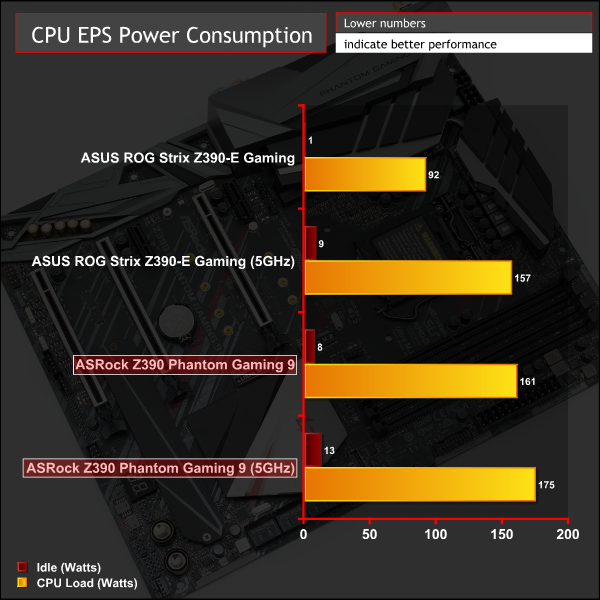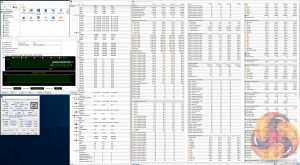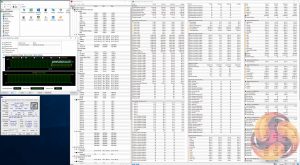Manual CPU Overclocking:
To test the ASRock Z390 Phantom Gaming 9 motherboard’s CPU overclocking potential, we set the CPU core voltage no higher than 1.3V and push for the highest stable clock speed. We maintain the DRAM frequency at 3200MHz to take memory stability out of the overclocking equation.
Our particular CPU is not stable at 5.1GHz even with 1.45v. The final stable overclock for almost all Z390 motherboards we may test should be 5GHz, unless there is something particularly wrong with the VRM that limits the voltage or power it can supply. In the case of the ASRock Z390 Phantom Gaming 9 it achieved 5GHz at 1.3 volts with no issues at all.
Motherboard Sensors
The ASRock Z390 Phantom 9 has two dedicated VRM sensors on a separate IC to measure temperature, as well as input and output voltage. From our testing the following results were achieved:
- Stock – 67 degrees Celsius bank 1 (VCore) and 52 degrees Celsius bank 2 (VCore, iGPU, VCCSA, VCCIO)
- OC – 73 degrees Celsius bank 1 (VCore) and 56 degrees Celsius bank 2 (VCore, iGPU, VCCSA, VCCIO)
These results suggest there is little to worry about when using air or closed-loop water cooling. These temperatures could become more problematic in restricted airflow cases or when pushing beyond 1.3 volts, however, for most users the VRM solution is robust enough to sustain a high overclock.
Overclocked Performance

Overclocked performance increases slightly. Keeping in mind Cinebench is only a short benchmark the performance goes from all-core 4.7GHz to all-core 5GHz which is a 6 per cent jump in frequency for a 5 percent gain in score.
That said the duration of the benchmark is mostly irrelevant for the ASRock motherboard as the Turbo duration has been tweaked to ensure maximum performance all of the time at stock, i.e. a 4.7GHz all core turbo.
On other motherboards where the CPU follows Intel Turbo guidance the gains from overclocking in longer benchmarks would be more noticeable (effectively going from 4.2GHz all core turbo to 5GHz), since overclocking takes the CPU beyond Intel's specification.
System Power Consumption
We leave the system to idle on the Windows 10 desktop for 10 minutes before taking a reading. For CPU load results we run AIDA64 CPU, FPU, Cache and Memory stress tests and take a reading after 10 minutes. The power consumption of our entire test system (at the wall) is shown in the chart.

That previously identified “never-ending” Turbo duration on the ASRock motherboard means the power consumption is elevated compared to the ASUS motherboard. For reference the ASUS motherboard would start off at around 200-220~ watts but drop away to 150 after the Turbo duration lapses. ASRock's auto settings ensure it never lapses, or does so after a very long period of time, hence the elevated power draw.
At overclocked loads the power consumption is similar although the ASRock motherboard consumes a small amount more since its core voltage stays at the hard-coded 1.3 volts, whereas the ASUS board dipped down to 1.28 from the defined 1.3 volts due to Auto LLC behaviour.
12-volt EPS Power Consumption
During the 10-minute stress test as specified above, we record the direct CPU power consumption drawn through the EPS 8-pin socket using modified EPS 8-pin cables that have a Tinkerforge Voltage/Current 1.0 bricklet intercepting and monitoring the power flow from the power supply. That bricklet then reports its data to a Tinkerforge Master Brick. All the data collected by the Tinkerforge Master Brick is passed into an external laptop over a USB connection and analysed in the Cybenetics Powenetics Project software.

Stock CPU power consumption represents approximately 19% for idle and 82% for load of the system total, when adjusted for PSU efficiency*.
Overclocked CPU power consumption represents approximately 28% for idle and 84% for load of the system total, when adjusted for PSU efficiency*.
*Approximate Seasonic SS-760XP PSU efficiency at:
- 50-watts: 86%
- 125-watts: 89%
- 200-watts: 90%
The Powenetics software provides the power consumption at 12v input (pre-CPU VRM), and the CPU provides the power consumption (CPU IA Cores Power) after the CPU VRM has translated the power into a useful format (post-VRM). Based on this we can provide a rough estimate of VRM efficiency and “wasted” energy that likely translates into heat.
- Stock: 132-watts reported by CPU, 161-watts recorded, approximately 82% efficient and 29-watts of heat output.
- Overclocked: 155-watts reported, 175-watts recorded, approximately 88% efficient and 20-watts of heat output.
ASRock also provides VRM level input and output power statistics and these give the following results:
- Stock: 127-watts VRM output, 153-watts VRM input, approximately 83% efficient and 26-watts of heat output.
- Overclocked: 138-watts VRM output, 167-watts VRM input, approximately 83% efficient and 27-watts of heat output.
 KitGuru KitGuru.net – Tech News | Hardware News | Hardware Reviews | IOS | Mobile | Gaming | Graphics Cards
KitGuru KitGuru.net – Tech News | Hardware News | Hardware Reviews | IOS | Mobile | Gaming | Graphics Cards





